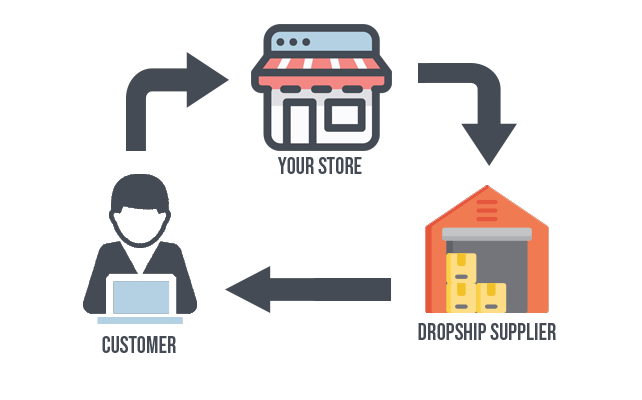
Dropshipping is becoming one of the most popular ways of doing business online. Ecommerce giants like Amazon, Walmart and Wayfair and small businesses alike utilize the dropship fulfillment model for their businesses. As more and more ecommerce businesses venture into the dropshipping realm, they find themselves needing a solution to streamline how they run their companies including how they automate the dropshipping side of their businesses.
The Dropshipping Fulfillment Model
To understand how dropship automation is incorporated into the ecommerce business model, it is important to first fully understand how dropship fulfillment works.
When a customer comes into an online store and places an order for a dropship product, the order will need to be sent to the dropship supplier, either manually or automatically, to be fulfilled. The supplier then will send out the order directly to the customer. The retailer is only charged the wholesale cost and shipping fee of the product, which is where the profit is made, and the retailer is also only charged when an order gets placed.

So, it is vital to an online retailer to make sure their dropship inventory and orders are managed well in order to obtain the sales, gain repeat customers and reduce selling out-of-stock products. One way to do that is to automate the whole dropshipping process from inventory data to orders.
Automating Dropship Inventory
In dropshipping, it is crucial ecommerce retailers have updated inventory data incorporated into their online stores. Dropship suppliers provide inventory data feeds (often updated multiple times throughout the day) to their resellers with current inventory levels and product data. There a few options online retailers have to import this data feed into their store.

1. Manual Inventory Import
To do this manually would mean an online retailer would have to upload the dropship supplier’s inventory feed into their online store builder every day to ensure they are up-to-date and accurate with the current stock levels, pricing changes and data for all of their dropship products. Some businesses even hire out people to do this for them. As you can imagine, this can be a time-consuming, tedious and potentially expensive task for any ecommerce business. But, it is more common than one might think.
2. Custom Scripts
Another option, if a retailer doesn’t want to manually import product feeds every day, is to hire a developer to write a custom script for their ecommerce business that can do this automatically. However a downfall of using this automation option would be that custom coding tends to be an expensive process, difficult to maintain and often proves unreliable.
3. Dropship Automation Software
When manual imports and custom scripting isn’t an option for starting your ecommerce business, there is dropship automation software. With dropship automation software, retailers can automatically sync their supplier’s inventory feeds directly into their store multiple times a day, saving a lot of time, headache and money. Not only can it automatically sync an inventory data feed, but retailers also have the ability to manage and customize their store’s product feed right within the automation software
It’s easy to see here that dropship automation software offers the most in terms of functionality, reliability and ease-of-use for automating inventory management for ecommerce retailers.
Automating Dropship Orders
After automating the inventory management side of the dropshipping fulfillment model, the retailer now has to figure out how to manage their dropship orders. The efficient handling of orders is instrumental in gaining repeat customers and effectively managing your business.

There are multiple ways suppliers accept dropship orders, which can vary depending on the supplier you utilize:
One of the most popular way suppliers accept orders is through email. Some suppliers don’t require any formatting when it comes to submitting orders via email, but others require a formatted attachment, such as within a spreadsheet It is also important to note that most of the major ecommerce platforms allow retailers to automatically send email orders to their supplier once they have been placed - only if they don’t require a specific file format attachment.
Website / Dealer Portal
Most dropshipping suppliers have some sort of dealer portal within their website where retailers can manage or place dropship orders. Sometimes, suppliers will only accept orders placed through this method. While simple, it is a very manual process that can become time consuming when receiving a lot of dropship orders.
API / EDI
As with custom scripting in inventory data feeds, if a supplier allows a retailer to automate orders through an API or EDI, it is almost always a requirement to hire a developer and develop custom coding. As stated before, doing so can often be hard to maintain and can break, which can get expensive for a business.
FTP Folder
Similarly with automating orders via an API or EDI, FTP order automation requires the work of a developer to automatically send an FTP file to the supplier once an order gets placed.
Over the Phone
As one can imagine, this is a time consuming task that has large room for error. Without help from an assistant, over the phone orders is not usually feasible for an expanding dropshipping business.
Dropship Automation Software
This is where dropship automation software comes into play again to automate the order side of the dropship fulfillment model. Dropship automation software can make the lives of the ecommerce retailers a lot easier when it comes to automating and managing dropship orders. This type of software takes care of the difficult tasks for you, like the coding and maintenance of automation that saves online retailers precious time and money, which is critical when starting to dropship.
Once an order gets placed with an online retailer, the order information automatically syncs into an order management system within the dropship automation software, which subsequently sends it out to the corresponding dropship suppliers. Once the supplier ships the product(s), the tracking information is then sent back through the order management system, which will automatically push it back to your store and customer. No emails, no calling and no hiring of developers necessary.
Automating dropship inventory and orders doesn’t have to be difficult, costly or time consuming.





Leave a reply or comment below